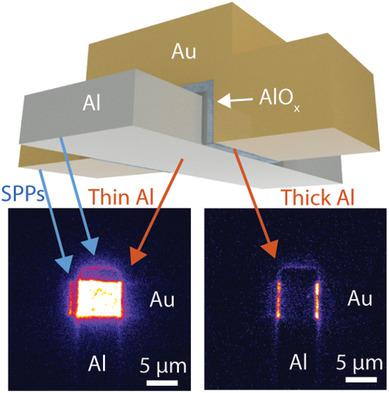Our official English website, www.x-mol.net, welcomes your
feedback! (Note: you will need to create a separate account there.)
Efficient Surface Plasmon Polariton Excitation and Control over Outcoupling Mechanisms in Metal-Insulator-Metal Tunneling Junctions.
Advanced Science ( IF 14.3 ) Pub Date : 2020-02-22 , DOI: 10.1002/advs.201900291 Ksenia S Makarenko 1 , Thanh Xuan Hoang 2 , Thorin J Duffin 1, 3 , Andreea Radulescu 1, 3 , Vijith Kalathingal 1, 4 , Henri J Lezec 5 , Hong-Son Chu 2 , Christian A Nijhuis 1, 3, 4, 6
Advanced Science ( IF 14.3 ) Pub Date : 2020-02-22 , DOI: 10.1002/advs.201900291 Ksenia S Makarenko 1 , Thanh Xuan Hoang 2 , Thorin J Duffin 1, 3 , Andreea Radulescu 1, 3 , Vijith Kalathingal 1, 4 , Henri J Lezec 5 , Hong-Son Chu 2 , Christian A Nijhuis 1, 3, 4, 6
Affiliation

|
Surface plasmon polaritons (SPPs) are viable candidates for integration into on-chip nano-circuitry that allow access to high data bandwidths and low energy consumption. Metal-insulator-metal tunneling junctions (MIM-TJs) have recently been shown to excite and detect SPPs electrically; however, experimentally measured efficiencies and outcoupling mechanisms are not fully understood. It is shown that the MIM-TJ cavity SPP mode (MIM-SPP) can outcouple via three pathways to i) photons via scattering of MIM-SPP at the MIM-TJ interfaces, ii) SPPs at the metal-dielectric interfaces (bound-SPPs) by mode coupling through the electrodes, and iii) photons and bound-SPP modes by mode coupling at the MIM-TJ edges. It is also shown that, for Al-AlO x -Cr-Au MIM-TJs on glass, the MIM-SPP mode outcouples efficiently to bound-SPPs through either electrode (pathway 2); this outcoupling pathway can be selectively turned on and off by changing the respective electrode thickness. Outcoupling at the MIM-TJ edges (pathway 3) is efficient and sensitive to the edge topography, whereas most light emission originates from roughness-induced scattering of the MIM-SPP mode (pathway 1). Using an arbitrary roughness profile, it is demonstrated that various roughness facets can raise MIM-SPP outcoupling efficiencies to 0.62%. These results pave the way for understanding the topographical parameters needed to develop CMOS-compatible plasmonic circuitry elements.
中文翻译:

金属-绝缘体-金属隧道结中外耦合机制的高效表面等离子体激元激发和控制。
表面等离激元极化激元 (SPP) 是集成到片上纳米电路中的可行候选者,可实现高数据带宽和低能耗。最近,金属-绝缘体-金属隧道结 (MIM-TJ) 已被证明可以通过电方式激发和检测 SPP;然而,实验测量的效率和耦合机制尚未完全了解。结果表明,MIM-TJ 腔 SPP 模式 (MIM-SPP) 可以通过三种途径耦合到 i) 通过 MIM-TJ 界面处的 MIM-SPP 散射产生的光子,ii) 金属-电介质界面处的 SPP(束缚- SPP)通过电极的模式耦合,以及 iii)光子和束缚 SPP 模式通过 MIM-TJ 边缘的模式耦合。还表明,对于玻璃上的 Al-AlO x -Cr-Au MIM-TJ,MIM-SPP 模式通过任一电极有效地耦合至结合 SPP(路径 2);通过改变相应的电极厚度,可以选择性地打开和关闭该外耦合路径。MIM-TJ 边缘处的外耦合(路径 3)高效且对边缘形貌敏感,而大多数光发射源自 MIM-SPP 模式的粗糙度引起的散射(路径 1)。使用任意粗糙度轮廓,结果表明各种粗糙度面可以将 MIM-SPP 输出耦合效率提高至 0.62%。这些结果为理解开发 CMOS 兼容等离子体电路元件所需的拓扑参数铺平了道路。
更新日期:2020-04-21
中文翻译:

金属-绝缘体-金属隧道结中外耦合机制的高效表面等离子体激元激发和控制。
表面等离激元极化激元 (SPP) 是集成到片上纳米电路中的可行候选者,可实现高数据带宽和低能耗。最近,金属-绝缘体-金属隧道结 (MIM-TJ) 已被证明可以通过电方式激发和检测 SPP;然而,实验测量的效率和耦合机制尚未完全了解。结果表明,MIM-TJ 腔 SPP 模式 (MIM-SPP) 可以通过三种途径耦合到 i) 通过 MIM-TJ 界面处的 MIM-SPP 散射产生的光子,ii) 金属-电介质界面处的 SPP(束缚- SPP)通过电极的模式耦合,以及 iii)光子和束缚 SPP 模式通过 MIM-TJ 边缘的模式耦合。还表明,对于玻璃上的 Al-AlO x -Cr-Au MIM-TJ,MIM-SPP 模式通过任一电极有效地耦合至结合 SPP(路径 2);通过改变相应的电极厚度,可以选择性地打开和关闭该外耦合路径。MIM-TJ 边缘处的外耦合(路径 3)高效且对边缘形貌敏感,而大多数光发射源自 MIM-SPP 模式的粗糙度引起的散射(路径 1)。使用任意粗糙度轮廓,结果表明各种粗糙度面可以将 MIM-SPP 输出耦合效率提高至 0.62%。这些结果为理解开发 CMOS 兼容等离子体电路元件所需的拓扑参数铺平了道路。











































 京公网安备 11010802027423号
京公网安备 11010802027423号